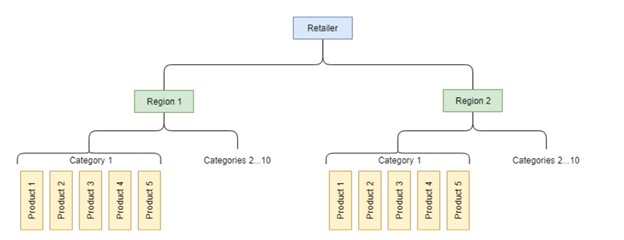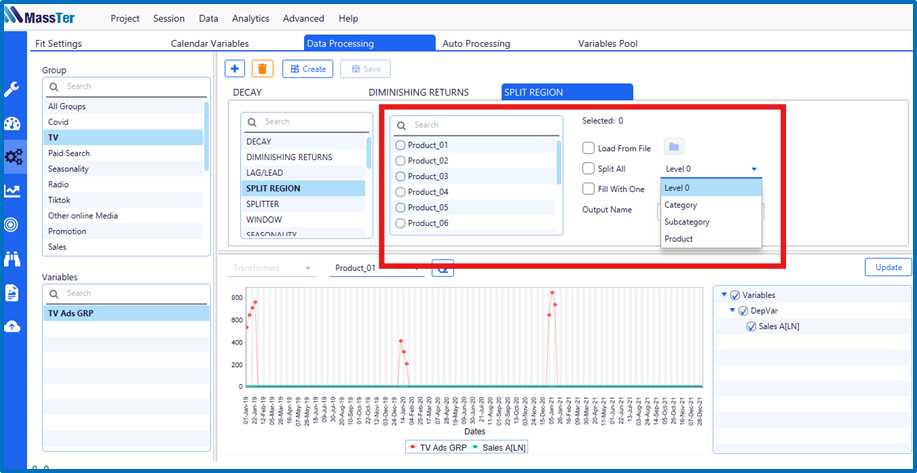Hierarchical Modeling in MMM:
From Big Picture to Fine Details
By Dr. Ramla Jarrar, Edited by Aziz Ben Hadj Yahia

As MMM modelers, we often face issues with capturing insights at the right granularity.
A campaign might work well in one region but flop in another. A promotion might drive sales for one product category while barely moving the needle for another.
So, how do we capture these nuances without oversimplifying or drowning in complexity?
This is where hierarchical modeling comes in.
Hierarchical modeling (also known as multilevel modeling) allows us to analyze marketing effectiveness across different levels – whether it’s by region, store, or product category – while recognizing the relationships between them.
Instead of treating all markets or products as the same, we can see how a campaign cascades through different layers, giving us a clearer picture of what’s working and where
In this blog, I’ll walk you through the fundamentals of hierarchical modeling in MMM, show you how brands use it to optimize their media spend, and explain how to apply it practically. Let’s go!
What is Hierarchical Modeling?
At its core, hierarchical modeling is a way to analyze data that has a natural structure or nested relationships. This is incredibly useful because marketing impact doesn’t operate in isolation—what works at one level may not work the same way at another.
Think of it like this: imagine you’re running a retail business with stores across multiple regions. Your marketing efforts – TV ads, social media campaigns, in-store promotions – don’t affect all regions, stores, or product categories equally. Hierarchical modeling helps capture these differences while maintaining a connection between them.
How It Works
Hierarchical modeling breaks data into multiple levels, typically following a structure like:
- Top Level (Region): Marketing campaigns may have different effects across regions due to factors like demographics, competition, and seasonality.
- Middle Level (Store): Even within the same region, different stores may respond differently based on factors like store size, foot traffic, or local competition.
- Bottom Level (Product Category): Within each store, certain product categories may benefit more from a campaign than others.
Instead of forcing a one-size-fits-all approach, hierarchical modeling allows us to account for these variations, making MMM much more precise.
A Simple Example
Let’s say we launch a TV campaign for a clothing retailer. If we apply a traditional MMM model without hierarchy, we might get an average impact across all regions. But in reality:
- The campaign could work really well in urban regions but have less impact in rural areas.
- Within an urban region, the effect might be stronger for flagship stores than smaller outlets.
- Even within a flagship store, the campaign might boost footwear sales significantly while having a smaller effect on accessories.
Hierarchical modeling captures these differences and helps us understand:
- Which regions need more or less investment?
- Which stores are responding well and why?
- Which product categories are benefiting the most?
Benefits of Using Hierarchical Modeling
1. Captures Nested Relationships
Real-world businesses are structured in layers—regions contain stores, stores sell different product categories, and categories contain multiple SKUs. Traditional MMM struggles to reflect this complexity, often applying a single marketing effect across all levels.
Hierarchical modeling explicitly accounts for these relationships, ensuring that:
- Store-level performance is influenced by regional factors.
- Product categories inherit effects from the store level but also have unique responses.
- Campaigns can have both broad and localized impacts.
Example:
A retail brand runs a national TV campaign. Instead of assuming the same impact everywhere, hierarchical modeling shows:
- Big cities see strong gains, while rural areas show a weaker response.
- Flagship stores experience a higher lift, whereas convenience stores see little impact.
- Luxury product categories benefit more from TV than lower-cost items.
By modeling these nested effects, we align our insights with real-world business structures, making them far more actionable.
2. Handles Variability Better
One major limitation of traditional MMM is that it assumes marketing channels have the same effect everywhere. But in reality, the impact of marketing is highly variable across locations, products, and customer segments.
Hierarchical modeling allows us to account for this variability by introducing:
- Random Slopes & Intercepts: Instead of assuming a fixed impact for TV, we let the model estimate how much it varies across different regions or stores.
- Adaptive Learning: When data is sparse at a lower level (e.g., individual stores), the model borrows insights from higher levels to improve accuracy.
Example:
A brand advertising on TikTok sees:
- Younger-skewing regions respond well, while older-skewing regions see little lift.
- TikTok ads for new fashion trends perform better than for evergreen products.
- In some regions, TikTok outperforms TV, while in others, the reverse is true.
Without hierarchical modeling, we might miss these insights and assume TikTok works equally well everywhere—which could lead to wasted spend.
3. Improves Interpretability and Decision-Making
One of the biggest frustrations in MMM is dealing with thousands of independent coefficients, making it difficult to draw meaningful conclusions. Hierarchical modeling solves this by organizing insights in a structured way.
Instead of just providing a long list of numbers, hierarchical modeling offers:
- Category-Level Insights: “TV increases sales for premium products by 12% but only 4% for budget products.”
- Store-Level Insights: “Mall-based stores see double the impact of standalone stores.”
- Regional Insights: “The campaign was twice as effective in Southern regions compared to Northern regions.”
This structured approach makes it easier for marketers to take action and optimize campaigns accordingly.
Case Study: How a Retailer Uses Hierarchical Modeling
A national retail chain is investing heavily in marketing – TV ads, social media, digital, and in-store promotions. But they’re struggling to answer key questions:
- Does TV advertising drive sales equally across all regions?
- How do individual stores respond to different media channels?
- Do product categories within the same store react differently to the same campaign?
Their traditional MMM approach gives them an average marketing impact, but they know that some stores and product categories are performing far better than others. They need a more granular, data-driven way to optimize their spend.
Applying Hierarchical Modeling
By structuring their analysis hierarchically, they break their data into three levels:
- Region Level – Capturing broad geographic differences.
- Store Level – Understanding how store characteristics impact performance.
- Category Level – Seeing how product types react differently within stores.
Now, instead of treating all locations and products the same, they can layer in complexity while maintaining structure.
Hierarchical modeling reveals key insights they wouldn’t have seen otherwise:
✅ Regional Differences:
- TV campaigns are highly effective in urban areas but show diminishing returns in rural regions.
- Some regions respond better to social media than TV, shifting how they allocate their budget.
✅ Store-Level Insights:
- Large flagship stores see higher ad-driven foot traffic, whereas smaller stores rely more on local promotions.
- Stores located in malls benefit more from joint marketing efforts with neighboring retailers.
✅ Category-Specific Impact:
- Footwear sales skyrocket after TV ads, while accessories see minimal impact.
- Some stores experience a halo effect, where TV campaigns boost sales of related categories (e.g., a sneaker ad increases sock sales).
By leveraging these insights, the retailer shifts budget dynamically:
- Reducing TV spend in underperforming regions and doubling down on digital where it works best.
- Allocating more in-store promotions for smaller stores that don’t benefit as much from national media.
- Optimizing cross-category promotions to capitalize on halo effects.
As a result, they see a 10% increase in marketing ROI—simply by adjusting their spend based on hierarchical insights rather than relying on a flat, one-size-fits-all MMM approach.
Hierarchical Modeling in MassTer
At MASS Analytics, we’ve built MassTer to handle the complexities of real-world marketing data – especially when it comes to granularity. Hierarchical modeling plays a key role in helping businesses move beyond broad averages and extract actionable insights at different levels.
Here’s how MassTer applies hierarchical modeling across the modeling phase.
1. Automating Regional Segmentation
One of the biggest challenges in hierarchical modeling is properly structuring the data. If you get this step wrong, you risk inaccurate or misleading insights.
With MassTer, segmenting data across multiple hierarchical levels happens automatically, reducing manual effort and minimizing errors.
- Automatically assigns regions, stores, and product categories based on predefined structures.
- Speeds up data preparation, ensuring consistency in model inputs.
- Helps standardize how different levels interact before running the model.
This means users can focus on insights instead of spending time cleaning and structuring their data manually.
2. Capturing Granular Marketing Effects
MassTer applies hierarchical modeling in two key ways:
- a) Variable Slopes at Different Levels
Marketing effectiveness isn’t uniform across different regions, stores, or product categories. Instead of assuming one-size-fits-all coefficients, MassTer allows:
- Category-Level Adjustments: Some marketing channels (e.g., Google Display) have different effects on luxury vs. budget products.
- Product-Level Adjustments: Even within the same category, individual products might respond differently to ads.
- Random Slopes & Intercepts: These account for unobserved heterogeneity, ensuring the model learns the true underlying effects rather than forcing a single fixed value.
Example: Instead of applying a single TV effectiveness rate across all categories, MassTer estimates how much TV contributes to each category separately, capturing nuances like:
- TV driving strong lift for high-end sneakers but minimal impact on accessories.
- Google Display being more effective for new product launches than for evergreen products.
- b) Measuring the Halo Effect
Some marketing efforts don’t just impact their intended product category—they have spillover effects. MassTer accounts for cross-category influence by explicitly modeling halo effects.
Example:
- A TV ad for salty snacks might not only boost snack sales but also increase beverage sales (since people often buy them together).
- MassTer ensures that the model captures this indirect impact instead of attributing all gains to snack sales alone.
By incorporating these effects, we provide a more holistic view of how marketing efforts truly drive revenue.
3. Smarter Reporting & Decision-Making
Once the model is built, the next challenge is making sense of the results at different levels. This is where MassTer’s hierarchical approach really shines.
With our automated reporting, businesses can view results at multiple levels, including:
- Category-Level Insights: Understand which marketing channels work best for each product category.
- Subcategory-Level Insights: See how different product segments (e.g., high-end vs. budget) react differently.
- Product-Level Insights: Identify top-performing SKUs and optimize spend accordingly.
Instead of forcing teams to sift through complex data tables, MassTer automatically structures insights to match real-world decision-making.
Best Practices for Using Hierarchical Modeling in MMM
An incorrectly specified hierarchical model can lead to misinterpretation, unnecessary complexity, or even misleading insights. Here are some best practices to ensure you’re maximizing the value of hierarchical modeling while keeping things manageable.
1. Clearly Define Your Hierarchy Before Modeling
Before running your models, you need to establish the right levels of hierarchy. A poorly structured hierarchy can lead to confusing results or unnecessary complexity.
Ask yourself:
- What are the natural layers in my business? (e.g., Region → Store → Category)
- Does my data support this level of granularity?
- Are there enough data points at each level to get reliable estimates?
Example:
A retail company might structure its hierarchy as:
📍 Level 1: Regions (North, South, East, West)
🏬 Level 2: Stores (Flagship, Mall-based, Convenience)
🛍️ Level 3: Categories (Luxury, Budget, Essentials)
Tip: Start with the broadest levels and gradually introduce deeper layers only if they provide meaningful insights.
2. Avoid Overfitting by Balancing Granularity and Stability
While more granularity sounds great, there’s a risk of overfitting—where the model picks up noise instead of meaningful trends.
What to do:
- Use partial pooling, where product- or store-level data is informed by category- and region-level trends.
- If individual store-level data is too sparse, consider grouping stores into clusters instead.
- Regularly test whether adding extra layers improves predictions—if not, simplify!
Example:
If a model estimates TV effectiveness for every single store separately, results will be unstable for small stores with low data volume. Instead, group stores into meaningful segments like “large urban stores” vs. “small rural stores.”
3. Capture Both Direct and Halo Effects
One common mistake is focusing only on direct effects (e.g., TV drives sneaker sales) and missing halo effects (e.g., TV sneaker ads also boosting sock sales).
How to do this effectively:
- Include variables that track cross-category influence.
- Test whether advertising in one category has spillover effects on related products.
- Don’t assume all effects are linear—some marketing works best when categories are promoted together.
Example:
A supermarket might find that ads for beer also increase sales of snacks—but if you model each category in isolation, you might miss this insight.
4. Use Hierarchical Reporting for Smarter Decisions
Modeling is just half the battle – how you interpret the results is just as important. The goal is to make insights actionable at different levels of the business.
Best practices for reporting:
- Show high-level insights first (e.g., “TV boosted overall sales by 8%”).
- Then break it down by level (e.g., “TV drove a 12% lift in urban stores but only 3% in rural stores”).
- Provide clear, layered recommendations based on each level’s unique insights.
Example:
A fashion brand’s report might look like this:
📊 Overall: TV increased total sales by 8%
📍 Regional View: Strongest lift in London and Paris, weaker in smaller cities.
🛍️ Store View: Flagship stores benefited the most; smaller stores saw minimal impact.
👕 Category View: TV worked well for luxury items but had little effect on accessories.
This way, different teams (executives, media buyers, store managers) can all take relevant action.
Conclusion
Hierarchical modeling allows you to analyze marketing effectiveness at different levels, from broad regions to individual product categories.
By structuring data in a way that reflects real-world complexities, hierarchical modeling helps us:
- Capture nested relationships between regions, stores, and product categories.
- Handle variability across different levels, rather than assuming one-size-fits-all marketing effects.
- Improve interpretability, making insights more actionable for media planning and budget allocation.
- Optimize spend with precision, ensuring investments go where they drive the most impact.
At MASS Analytics, we’ve built hierarchical modeling capabilities directly into our platform to automate segmentation, model granular effects, and provide structured reporting – all without adding unnecessary complexity. If you’d like to see them in action, book a demo here.








